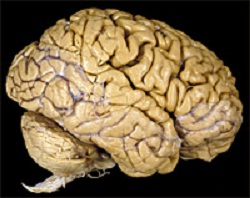
Description
The adult human brain weighs on average about 3lbs. (1.5kg) with a volume of around 1130 cubic centimetres (cm3) in women and 1260cm3 in men, although there is substantial individual variation.
The cerebral hemispheres form the largest part of the human brain and are situated above most other brain structures. They are covered with a cortical layer with a convoluted topography. Underneath the cerebrum lies the brain-stem, resembling a stalk on which the cerebrum is attached. At the rear of the brain, beneath the cerebrum and behind the brain-stem, is the cerebellum, a structure with a horizontally furrowed surface that makes it look different from any other brain area. The same structures are present in other mammals, although they vary considerably in relative size. As a rule, the smaller the cerebrum, the less convoluted the cortex. The cortex of a rat or mouse is almost perfectly smooth. The cortex of a dolphin or whale, on the other hand, is more convoluted than the cortex of a human.
Function
The brain is composed of neurons consisting of gray and white matter. The brain is the command centre sending impulses up to 170 mph down the spinal column and has nerve ending throughout the body.
Researchers who study the functions of the cortex divide it into three functional categories of regions, or areas. One consists of the primary sensory areas, which receive signals from the sensory nerves and tracts by way of relay nuclei in the thalamus. Primary sensory areas include the visual area of the occipital lobe, the auditory area in parts of the temporal lobe and insular cortex, and the somatosensory area in the parietal lobe. A second category is the primary motor area, which sends axons down to motor neurons in the brain-stem and spinal cord. This area occupies the rear portion of the frontal lobe, directly in front of the somatosensory area. The third category consists of the remaining parts of the cortex, which are called the association areas. These areas receive input from the sensory areas and lower parts of the brain and are involved in the complex process that we call perception, thought, and decision making.
Colour
Despite being referred to as grey matter, the live cortex is pinkish-beige in colour and slightly off-white in the interior.
Shape
Like a small very soft melon. The living brain is very soft, having a consistency similar to soft gelatin or soft tofu.
Location
In the cranium.
The adult human brain weighs on average about 3lbs. (1.5kg) with a volume of around 1130 cubic centimetres (cm3) in women and 1260cm3 in men, although there is substantial individual variation.
The cerebral hemispheres form the largest part of the human brain and are situated above most other brain structures. They are covered with a cortical layer with a convoluted topography. Underneath the cerebrum lies the brain-stem, resembling a stalk on which the cerebrum is attached. At the rear of the brain, beneath the cerebrum and behind the brain-stem, is the cerebellum, a structure with a horizontally furrowed surface that makes it look different from any other brain area. The same structures are present in other mammals, although they vary considerably in relative size. As a rule, the smaller the cerebrum, the less convoluted the cortex. The cortex of a rat or mouse is almost perfectly smooth. The cortex of a dolphin or whale, on the other hand, is more convoluted than the cortex of a human.
Function
The brain is composed of neurons consisting of gray and white matter. The brain is the command centre sending impulses up to 170 mph down the spinal column and has nerve ending throughout the body.
Researchers who study the functions of the cortex divide it into three functional categories of regions, or areas. One consists of the primary sensory areas, which receive signals from the sensory nerves and tracts by way of relay nuclei in the thalamus. Primary sensory areas include the visual area of the occipital lobe, the auditory area in parts of the temporal lobe and insular cortex, and the somatosensory area in the parietal lobe. A second category is the primary motor area, which sends axons down to motor neurons in the brain-stem and spinal cord. This area occupies the rear portion of the frontal lobe, directly in front of the somatosensory area. The third category consists of the remaining parts of the cortex, which are called the association areas. These areas receive input from the sensory areas and lower parts of the brain and are involved in the complex process that we call perception, thought, and decision making.
Colour
Despite being referred to as grey matter, the live cortex is pinkish-beige in colour and slightly off-white in the interior.
Shape
Like a small very soft melon. The living brain is very soft, having a consistency similar to soft gelatin or soft tofu.
Location
In the cranium.
 RSS Feed
RSS Feed
